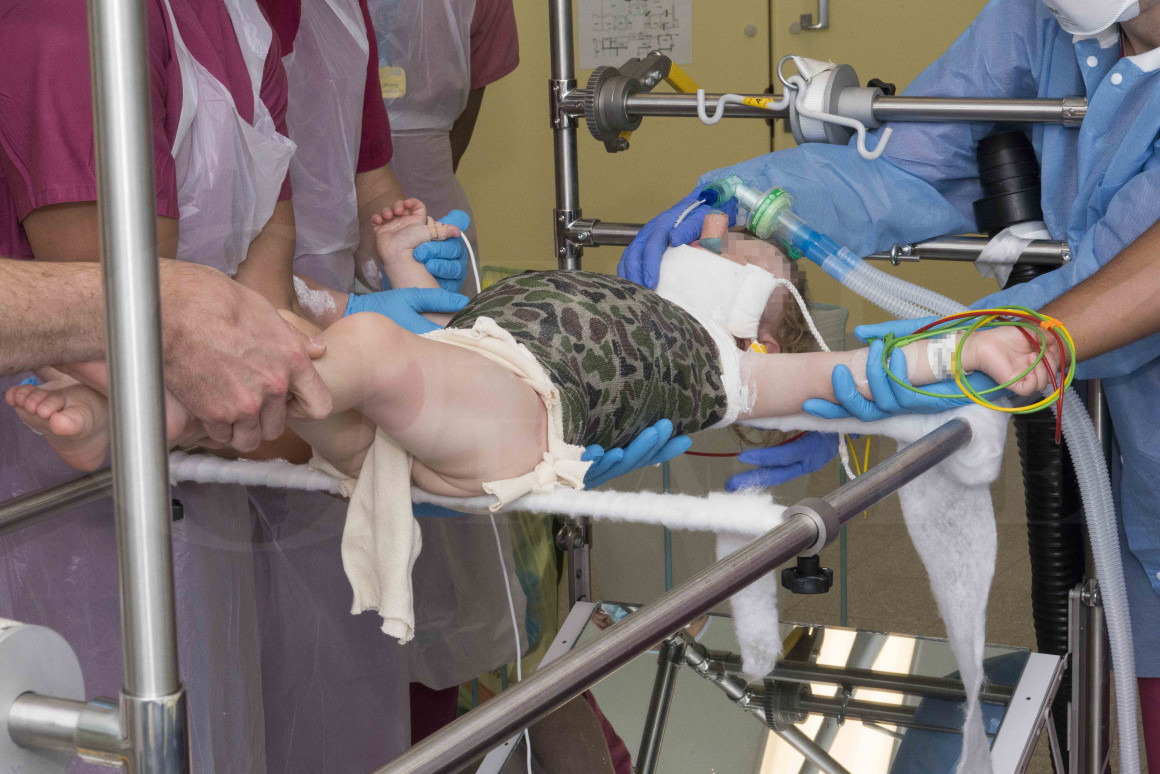EDF(Elongation-Derotation-Flexion)/Mehta casting for Early Onset Scoliosis
Overview

Subscribe to get full access to this operation and the extensive Spine Surgery Atlas.
Learn the EDF(Elongation-Derotation-Flexion)/Mehta casting for Early Onset Scoliosis surgical technique with step by step instructions on OrthOracle. Our e-learning platform contains high resolution images and a certified CME of the EDF(Elongation-Derotation-Flexion)/Mehta casting for Early Onset Scoliosis surgical procedure.
The treatment of children with early progressive scoliosis occurring before age 10 years is challenging but those presenting with progressive scoliosis before the age of 5 years can be particularly difficult to manage since the first five to ten years of life are a critical period for thoracic cage and spinal column development and growth.
Young children have a significant rate of growth and that is reflected in progression of their spinal curves. Scoliosis increases with growth and the rate of deterioration keeps pace with the rate of growth of the child, being greatest in infancy and adolescence.
The natural history of untreated or late treated progressive curves is that they may produce significant thoracic deformity which may lead to deleterious effects on the cardiopulmonary system.
John James (1954) described three types of idiopathic scoliosis – Infantile, Juvenile and Adolescent – on the basis of the age of onset: infantile denoted curves that developed before three years of age; juvenile, those that developed between four and nine years of age; and adolescent, those occurring between ten years of age and the time at which skeletal growth is complete.
The infantile and adolescent periods are marked by an increased growth velocity, whereas most of the juvenile period, in contrast, correlates with a deceleration of spinal growth. Consequently, the onset of scoliosis is relatively uncommon during the juvenile period. Bob Dickson (1985) used the term “early onset” to reflect the presence of scoliosis by five years of age and “late onset” for the appearance of scoliosis older than 5 years.
The Growing Spine Study Group (GSSG), the Children’s Spine Study Group and the Scoliosis Research Society have developed and endorsed the definition of early-onset scoliosis (EOS) as ‘‘scoliosis with onset less than the age of ten years, regardless of aetiology”.
EOS includes an inhomogeneous grouping of patients because the aetiology of the spinal deformity may be idiopathic (resolving or progressive), associated with underlying systemic syndrome, secondary to a neuromuscular condition or caused by a structural congenital spinal deformity. Regardless of aetiology, the age of onset remains an important factor for treatment because curves that demonstrate a major thoracic deformity before a child is five years of age are more likely to be associated with pulmonary complications in addition to other growth abnormalities.
The role of surgery is limited in these early onset cases: Although fusion sparing procedures are available complications are high, including the inadvertent auto fusion of the spine. Early fusion of the very immature thoracic spine results in many unfortunate sequala including thoracic insufficiency syndrome.
The goal of treatment in EOS is to control deformity progression, such that the need for spinal fusion is delayed or eliminated, without compromising normal spinal, thoracic and pulmonary growth and development.
Casting for Early Onset Scoliosis
Benefits of serial casting in EOS include improved patient compliance, decreased invasiveness, reduced risk of spontaneous fusion and avoidance of complications associated with serial lengthening procedures.
Although the use and acceptance of serial body casts for the treatment of EOS is relatively recent; plaster of Paris (POP) cast use in the treatment of spine deformity dates back to the 19th century. Lewis Sayer, an American Orthopaedic surgeon, reported his technique and experience on how to correct spinal deformities with traction (partial suspension) and application of POP cast as far back as 1877.
Multiple techniques and reports were subsequently published using casting in the treatment of scoliosis (Bradford and Brackett 1893, Risser 1955, Cotrel and Morel 1964) but the first formal report of serial casting specifically addressing idiopathic EOS was presented by Min Mehta and Yves Cotrel in 1979.
Although the goal of serial casting treatment is deformity resolution, for many patients, especially those with non-idiopathic aetiologies, casting can be used simply as a tactic to delay surgery as even growth-sparing constructs can hinder spinal growth and chest wall compliance and carry with them the inherent risks and complications associated with repetitive surgery.
In this technique I describe my technique of elongation-derotation-flexion (lateral flexion) casting (EDF) application for the treatment of Early Onset Scoliosis.
Readers will also find the following OrthOracle techniques of interest:
Anterior release of scoliosis (access by thoracotomy)
T11 to L3 anterior scoliosis correction and fusion with the Globus Anterior Staple System
Author: Mr Neil Upadahay FRCS (Tr & Orth)
Institution: The Avon Orthopaedic Centre, Southmead Hospital, Bristol, UK.
Clinicians should seek clarification on whether any implant demonstrated is licensed for use in their own country.
In the USA contact: fda.gov
In the UK contact: gov.uk
In the EU contact: ema.europa.eu
Online learning is only available to subscribers.



















